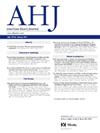Medical Treatment of Hypercortisolism with Relacorilant: Final Results of the Phase 3 GRACE Study
IF 3.7
2区 医学
Q1 CARDIAC & CARDIOVASCULAR SYSTEMS
引用次数: 0
Abstract
Diabetic cardiomyopathy (DCM) is a cardiometabolic syndrome, manifested by ventricular diastolic or systolic dysfunction which occurs in approximately 12% of diabetic patients. Diabetes perpetuates the development of microvascular complications that can exacerbate cardiovascular pathologies. Understanding the common molecular targets underlying these two conditions is important for designing effective interventions that can address diabetes and related complications simultaneously. Herein, we aim to investigate the underlying network of key modules associated with diabetic cardiomyopathy. In current study, microarray gene expression profiles of diabetic and cardiomyopathy patients possessing accession number (GSE30122 and GSE20966) and (GSE89714, GSE3586, and GSE1145) were retrieved from Gene Expression Omnibus (GEO) database to explore key modulators. The differentially expressed genes (DEGs) were analyzed via GEO2R tool, based on the cut off criteria (p ≤ 0.05) and log2(FC)>|±1|. 37 overlapped DEGs were identified which then subjected to miRNA target prediction, protein-protein interaction (PPI) network construction and module screening via TargetScan, ShinyGO, STRING, and Cytoscape respectively, to screen hub genes as potential targets. Functional gene enrichment analysis identified enrichment of DEGs in heart contraction, apoptosis, cytokines signaling, beta adrenergic signaling and GPCR neurotransmitter receptor activity. The miRNA-mRNA regulatory network identified 9 hub genes, including ADRB1, TGFB2, RAP2A, CALD1, WIPF1, ATP10a, AKAP1, NR4A3, EXT1 and 4 hub miRNAs including miR-199-5, miR-200a, mir141-3, and miR-19-3p based on their degree of connectivity and centrality within the network. Conclusively, our analysis unveiled hub genes and miRNAs associated with diabetes-linked cardiomyopathy that might considered as biomarkers and offer a reliable tool for developing effective therapeutic strategies in future.
求助全文
约1分钟内获得全文
求助全文
来源期刊

American heart journal
医学-心血管系统
CiteScore
8.20
自引率
2.10%
发文量
214
审稿时长
38 days
期刊介绍:
The American Heart Journal will consider for publication suitable articles on topics pertaining to the broad discipline of cardiovascular disease. Our goal is to provide the reader primary investigation, scholarly review, and opinion concerning the practice of cardiovascular medicine. We especially encourage submission of 3 types of reports that are not frequently seen in cardiovascular journals: negative clinical studies, reports on study designs, and studies involving the organization of medical care. The Journal does not accept individual case reports or original articles involving bench laboratory or animal research.
 求助内容:
求助内容: 应助结果提醒方式:
应助结果提醒方式:


